Flexible Organic Electrochemical Transistors for Energy-Efficient Neuromorphic Computing
Abstract
:1. Introduction
2. Materials and Methods
3. Results and Discussion
4. Conclusions
Author Contributions
Funding
Data Availability Statement
Conflicts of Interest
References
- Neumann, J.V. The Principles of Large-Scale Computing Machines. Ann. Hist. Comput. 1981, 3, 263–273. [Google Scholar] [CrossRef]
- Manipatruni, S.; Nikonov, D.E.; Young, I.A. Beyond CMOS computing with spin and polarization. Nat. Phys. 2018, 14, 338–343. [Google Scholar] [CrossRef]
- Merolla, P.A.; Arthur, J.V.; Alvarez-Icaza, R.; Cassidy, A.S.; Sawada, J.; Akopyan, F.; Jackson, B.L.; Imam, N.; Guo, C.; Nakamura, Y.; et al. A million spiking-neuron integrated circuit with a scalable communication network and interface. Science 2014, 345, 668–673. [Google Scholar] [CrossRef] [PubMed]
- Zidan, M.A.; Strachan, J.P.; Lu, W.D. The future of electronics based on memristive systems. Nat. Electron. 2018, 1, 22–29. [Google Scholar] [CrossRef]
- Bhunia, R.; Boahen, E.K.; Kim, D.J.; Oh, H.; Kong, Z.; Kim, D.H. Neural-inspired artificial synapses based on low-voltage operated organic electrochemical transistors. J. Mater. Chem. C 2023, 11, 7485–7509. [Google Scholar] [CrossRef]
- Yang, J.-T.; Ge, C.; Du, J.-Y.; Huang, H.-Y.; He, M.; Wang, C.; Lu, H.-B.; Yang, G.-Z.; Jin, K.-J. Artificial Synapses Emulated by an Electrolyte-Gated Tungsten-Oxide Transistor. Adv. Mater. 2018, 30, 1801548. [Google Scholar] [CrossRef]
- van de Burgt, Y.; Lubberman, E.; Fuller, E.J.; Keene, S.T.; Faria, G.C.; Agarwal, S.; Marinella, M.J.; Alec Talin, A.; Salleo, A. A non-volatile organic electrochemical device as a low-voltage artificial synapse for neuromorphic computing. Nat. Mater. 2017, 16, 414–418. [Google Scholar] [CrossRef]
- Yang, B.; Wang, Y.; Hua, Z.; Zhang, J.; Li, L.; Hao, D.; Guo, P.; Xiong, L.; Huang, J. Low-power consumption light-stimulated synaptic transistors based on natural carotene and organic semiconductors. Chem. Commun. 2021, 57, 8300–8303. [Google Scholar] [CrossRef]
- Schneider, M.L.; Donnelly, C.A.; Russek, S.E.; Baek, B.; Pufall, M.R.; Hopkins, P.F.; Dresselhaus, P.D.; Benz, S.P.; Rippard, W.H. Ultralow power artificial synapses using nanotextured magnetic Josephson junctions. Sci. Adv. 2018, 4, e1701329. [Google Scholar] [CrossRef]
- Hu, M.; Li, H.; Chen, Y.; Wu, Q.; Rose, G.S.; Linderman, R.W. Memristor Crossbar-Based Neuromorphic Computing System: A Case Study. IEEE Trans. Neural Netw. Learn. Syst. 2014, 25, 1864–1878. [Google Scholar] [CrossRef]
- Wang, S.; Chen, C.; Yu, Z.; He, Y.; Chen, X.; Wan, Q.; Shi, Y.; Zhang, D.W.; Zhou, H.; Wang, X.; et al. A MoS2/PTCDA Hybrid Heterojunction Synapse with Efficient Photoelectric Dual Modulation and Versatility. Adv. Mater. 2019, 31, 1806227. [Google Scholar] [CrossRef]
- Saleem, A.; Kumar, D.; Wu, F.; Keong, L.B.; Tseng, T.Y. An Opto-Electronic HfOx-Based Transparent Memristive Synapse for Neuromorphic Computing System. IEEE Trans. Electron Devices 2023, 70, 1351–1358. [Google Scholar] [CrossRef]
- Li, Q.; Wang, T.; Hu, X.; Wu, X.; Zhu, H.; Ji, L.; Sun, Q.; Zhang, D.W.; Chen, L. Organic Optoelectronic Synaptic Devices for Energy-Efficient Neuromorphic Computing. IEEE Electron Device Lett. 2022, 43, 1089–1092. [Google Scholar] [CrossRef]
- Chen, S.; Li, E.; Yu, R.; Yang, H.; Yan, Y.; Hu, Y.; Chen, H.; Guo, T. An organic synaptic transistor with integration of memory and neuromorphic computing. J. Mater. Chem. C 2021, 9, 9972–9981. [Google Scholar] [CrossRef]
- Monalisha, P.; Kumar, A.P.S.; Wang, X.R.; Piramanayagam, S.N. Emulation of Synaptic Plasticity on a Cobalt-Based Synaptic Transistor for Neuromorphic Computing. ACS Appl. Mater. Interfaces 2022, 14, 11864–11872. [Google Scholar] [CrossRef] [PubMed]
- Shi, Y.; Fong, S.; Wong, H.S.P.; Kuzum, D. Synaptic Devices Based on Phase-Change Memory. In Neuro-Inspired Computing Using Resistive Synaptic Devices; Yu, S., Ed.; Springer International Publishing: Berlin/Heidelberg, Germany, 2017; pp. 19–51. [Google Scholar]
- Indiveri, G.; Liu, S.C. Memory and Information Processing in Neuromorphic Systems. Proc. IEEE 2015, 103, 1379–1397. [Google Scholar] [CrossRef]
- Tang, J.; Yuan, F.; Shen, X.; Wang, Z.; Rao, M.; He, Y.; Sun, Y.; Li, X.; Zhang, W.; Li, Y.; et al. Bridging Biological and Artificial Neural Networks with Emerging Neuromorphic Devices: Fundamentals, Progress, and Challenges. Adv. Mater. 2019, 31, 1902761. [Google Scholar] [CrossRef] [PubMed]
- Thomas, A.; Resmi, A.N.; Ganguly, A.; Jinesh, K.B. Programmable electronic synapse and nonvolatile resistive switches using MoS2 quantum dots. Sci. Rep. 2020, 10, 12450. [Google Scholar] [CrossRef] [PubMed]
- Das, B.C.; Pillai, R.G.; Wu, Y.; McCreery, R.L. Redox-Gated Three-Terminal Organic Memory Devices: Effect of Composition and Environment on Performance. ACS Appl. Mater. Interfaces 2013, 5, 11052–11058. [Google Scholar] [CrossRef] [PubMed]
- van de Burgt, Y.; Melianas, A.; Keene, S.T.; Malliaras, G.; Salleo, A. Organic electronics for neuromorphic computing. Nat. Electron. 2018, 1, 386–397. [Google Scholar] [CrossRef]
- Serenko, M.V.; Prudnikov, N.V.; Emelyanov, A.V.; Stupnikov, A.A.; Malakhova, Y.N.; Savinov, D.V.; Erokhin, V.V. Resistive switching kinetics of electrolyte-gated polyaniline-based memristive devices. Org. Electron. 2024, 126, 107002. [Google Scholar] [CrossRef]
- Prudnikov, N.; Malakhov, S.; Kulagin, V.; Emelyanov, A.; Chvalun, S.; Demin, V.; Erokhin, V. Multi-Terminal Nonwoven Stochastic Memristive Devices Based on Polyamide-6 and Polyaniline for Neuromorphic Computing. Biomimetics 2023, 8, 189. [Google Scholar] [CrossRef] [PubMed]
- Bu, X.; Xu, H.; Shang, D.; Li, Y.; Lv, H.; Liu, Q. Ion-Gated Transistor: An Enabler for Sensing and Computing Integration. Adv. Intell. Syst. 2020, 2, 2000156. [Google Scholar] [CrossRef]
- Zhang, J.; Guo, P.; Guo, Z.; Li, L.; Sun, T.; Liu, D.; Tian, L.; Zu, G.; Xiong, L.; Zhang, J.; et al. Retina-Inspired Artificial Synapses with Ultraviolet to Near-Infrared Broadband Responses for Energy-Efficient Neuromorphic Visual Systems. Adv. Funct. Mater. 2023, 33, 2302885. [Google Scholar] [CrossRef]
- Shkodra, B.; Petrelli, M.; Douaki, A.; Ahmad, M.; Altana, A.; Petti, L.; Carrara, S.; Lugli, P. Spray-Coated Thin-Film Organic Memristor for Neuromorphic Applications. In Proceedings of the 2023 IEEE International Conference on Flexible and Printable Sensors and Systems (FLEPS), Boston, MA, USA, 9–12 July 2023; pp. 1–4. [Google Scholar]
- Boppidi, P.K.R.; Suresh, B.; Zhussupbekova, A.; Biswas, P.; Mullarkey, D.; Raj, P.M.P.; Shvets, I.V.; Kundu, S. Efficient Resistive Switching and Spike Rate Dependent Plasticity in a New CuCrO2 Memristor for Plausible Neuromorphic Systems. IEEE Trans. Electron Devices 2020, 67, 3451–3458. [Google Scholar] [CrossRef]
- He, Y.; Liu, R.; Jiang, S.; Chen, C.; Zhu, L.; Shi, Y.; Wan, Q. IGZO-based floating-gate synaptic transistors for neuromorphic computing. J. Phys. D Appl. Phys. 2020, 53, 215106. [Google Scholar] [CrossRef]
- Francis, C.; Fazzi, D.; Grimm, S.B.; Paulus, F.; Beck, S.; Hillebrandt, S.; Pucci, A.; Zaumseil, J. Raman spectroscopy and microscopy of electrochemically and chemically doped high-mobility semiconducting polymers. J. Mater. Chem. C 2017, 5, 6176–6184. [Google Scholar] [CrossRef]
- Leighton, C. Electrolyte-based ionic control of functional oxides. Nat. Mater. 2019, 18, 13–18. [Google Scholar] [CrossRef]
- Ke, S.; Fu, C.; Lin, X.; Zhu, Y.; Mao, H.; Zhu, L.; Wang, X.; Chen, C.; Wan, C.; Wan, Q. BCM Learning Rules Emulated by a-IGZO-Based Photoelectronic Neuromorphic Transistors. IEEE Trans. Electron Devices 2022, 69, 4646–4650. [Google Scholar] [CrossRef]
- Mannan, Z.I.; Kim, H.; Chua, L. Implementation of Neuro-Memristive Synapse for Long-and Short-Term Bio-Synaptic Plasticity. Sensors 2021, 21, 644. [Google Scholar] [CrossRef]
- Zhang, M.; Augustine, G.J. Synapsins and the Synaptic Vesicle Reserve Pool: Floats or Anchors? Cells 2021, 10, 658. [Google Scholar] [CrossRef] [PubMed]
- Regehr, W.G. Short-term presynaptic plasticity. Cold Spring Harb. Perspect. Biol. 2012, 4, a005702. [Google Scholar] [CrossRef] [PubMed]
- Ho, V.M.; Lee, J.-A.; Martin, K.C. The Cell Biology of Synaptic Plasticity. Science 2011, 334, 623–628. [Google Scholar] [CrossRef] [PubMed]
- Zhu, Y.; He, Y.; Chen, C.; Zhu, L.; Wan, C.; Wan, Q. IGZO-based neuromorphic transistors with temperature-dependent synaptic plasticity and spiking logics. Sci. China Inf. Sci. 2022, 65, 162401. [Google Scholar] [CrossRef]
- Huang, W.; Hang, P.; Wang, Y.; Wang, K.; Han, S.; Chen, Z.; Peng, W.; Zhu, Y.; Xu, M.; Zhang, Y.; et al. Zero-power optoelectronic synaptic devices. Nano Energy 2020, 73, 104790. [Google Scholar] [CrossRef]
- Hu, X.; Meng, J.; Li, Q.; Wang, T.; Zhu, H.; Sun, Q.; Zhang, D.W.; Chen, L. Flexible Organic Optoelectronic Devices for Neuromorphic Computing. IEEE Electron Device Lett. 2023, 44, 1100–1103. [Google Scholar] [CrossRef]
- Lin, X.; Long, H.; Ke, S.; Wang, Y.; Zhu, Y.; Chen, C.; Wan, C.; Wan, Q. Indium-Gallium-Zinc-Oxide-Based Photoelectric Neuromorphic Transistors for Spiking Morse Coding. Chin. Phys. Lett. 2022, 39, 068501. [Google Scholar] [CrossRef]
- Zhang, J.; Sun, T.; Zeng, S.; Hao, D.; Yang, B.; Dai, S.; Liu, D.; Xiong, L.; Zhao, C.; Huang, J. Tailoring neuroplasticity in flexible perovskite QDs-based optoelectronic synaptic transistors by dual modes modulation. Nano Energy 2022, 95, 106987. [Google Scholar] [CrossRef]
- Lan, S.; Wang, X.; Yu, R.; Zhou, C.; Wang, M.; Cai, X. Organic Synaptic Transistors Based on a Hybrid Trapping Layer for Neuromorphic Computing. IEEE Electron Device Lett. 2022, 43, 1255–1258. [Google Scholar] [CrossRef]
- Wang, T.-Y.; Meng, J.-L.; Chen, L.; Zhu, H.; Sun, Q.-Q.; Ding, S.-J.; Bao, W.-Z.; Zhang, D.W. Flexible 3D memristor array for binary storage and multi-states neuromorphic computing applications. InfoMat 2021, 3, 212–221. [Google Scholar] [CrossRef]
- Zhu, J.; Yang, Y.; Jia, R.; Liang, Z.; Zhu, W.; Rehman, Z.U.; Bao, L.; Zhang, X.; Cai, Y.; Song, L.; et al. Ion Gated Synaptic Transistors Based on 2D van der Waals Crystals with Tunable Diffusive Dynamics. Adv. Mater. 2018, 30, 1800195. [Google Scholar] [CrossRef] [PubMed]
- Hu, W.; Jiang, J.; Xie, D.; Liu, B.; Yang, J.; He, J. Proton–electron-coupled MoS2 synaptic transistors with a natural renewable biopolymer neurotransmitter for brain-inspired neuromorphic learning. J. Mater. Chem. C 2019, 7, 682–691. [Google Scholar] [CrossRef]
- Zhu, Y.; Shin, B.; Liu, G.; Shan, F. Electrospun ZnSnO Nanofibers for Neuromorphic Transistors with Ultralow Energy Consumption. IEEE Electron Device Lett. 2019, 40, 1776–1779. [Google Scholar] [CrossRef]
- Li, J.; Yang, Y.H.; Fu, W.H.; Chen, Q.; Jiang, D.L.; Zhu, W.Q.; Zhang, J.H. Flexible transparent InZnO synapse transistor based on Li1.3Al0.3Ti0.7(PO4)3/polyvinyl pyrrolidone nanocomposites electrolyte film for neuromorphic computing. Mater. Today Phys. 2020, 15, 100264. [Google Scholar] [CrossRef]
- Liu, D.; Shi, Q.; Dai, S.; Huang, J. The Design of 3D-Interface Architecture in an Ultralow-Power, Electrospun Single-Fiber Synaptic Transistor for Neuromorphic Computing. Small 2020, 16, 1907472. [Google Scholar] [CrossRef]
- Lee, S.-K.; Cho, Y.W.; Lee, J.-S.; Jung, Y.-R.; Oh, S.-H.; Sun, J.-Y.; Kim, S.; Joo, Y.-C. Nanofiber Channel Organic Electrochemical Transistors for Low-Power Neuromorphic Computing and Wide-Bandwidth Sensing Platforms. Adv. Sci. 2021, 8, 2001544. [Google Scholar] [CrossRef]
- Zhao, Y.; Su, C.; Shen, G.; Xie, Z.; Xiao, W.; Fu, Y.; Inal, S.; Wang, Q.; Wang, Y.; Yue, W.; et al. Donor Engineering Tuning the Analog Switching Range and Operational Stability of Organic Synaptic Transistors for Neuromorphic Systems. Adv. Funct. Mater. 2022, 32, 2205744. [Google Scholar] [CrossRef]
- Li, M.; Shu, Q.; Qing, X.; Wu, J.; Xiao, Q.; Jia, K.; Wang, X.; Wang, D. Boron nitride-mediated semiconductor nanonetwork for an ultralow-power fibrous synaptic transistor and C-reactive protein sensing. J. Mater. Chem. C 2023, 11, 5208–5216. [Google Scholar] [CrossRef]
- Chen, T.; Yu, R.; Gao, C.; Chen, Z.; Chen, H.; Guo, T.; Chen, W. Low-energy-consumption organic synaptic transistors with high recognition accuracy enabled by Schottky barrier regulation. Sci. China Mater. 2023, 66, 4453–4463. [Google Scholar] [CrossRef]
- Lin, H.-A.; Weng, Y.-H.; Mulia, T.; Liu, C.-L.; Lin, Y.-C.; Yu, Y.-Y.; Chen, W.-C. Electrical Double-Layer Transistors Comprising Block Copolymer Electrolytes for Low-Power-Consumption Photodetectors. ACS Appl. Mater. Interfaces 2024, 16, 25042–25052. [Google Scholar] [CrossRef] [PubMed]
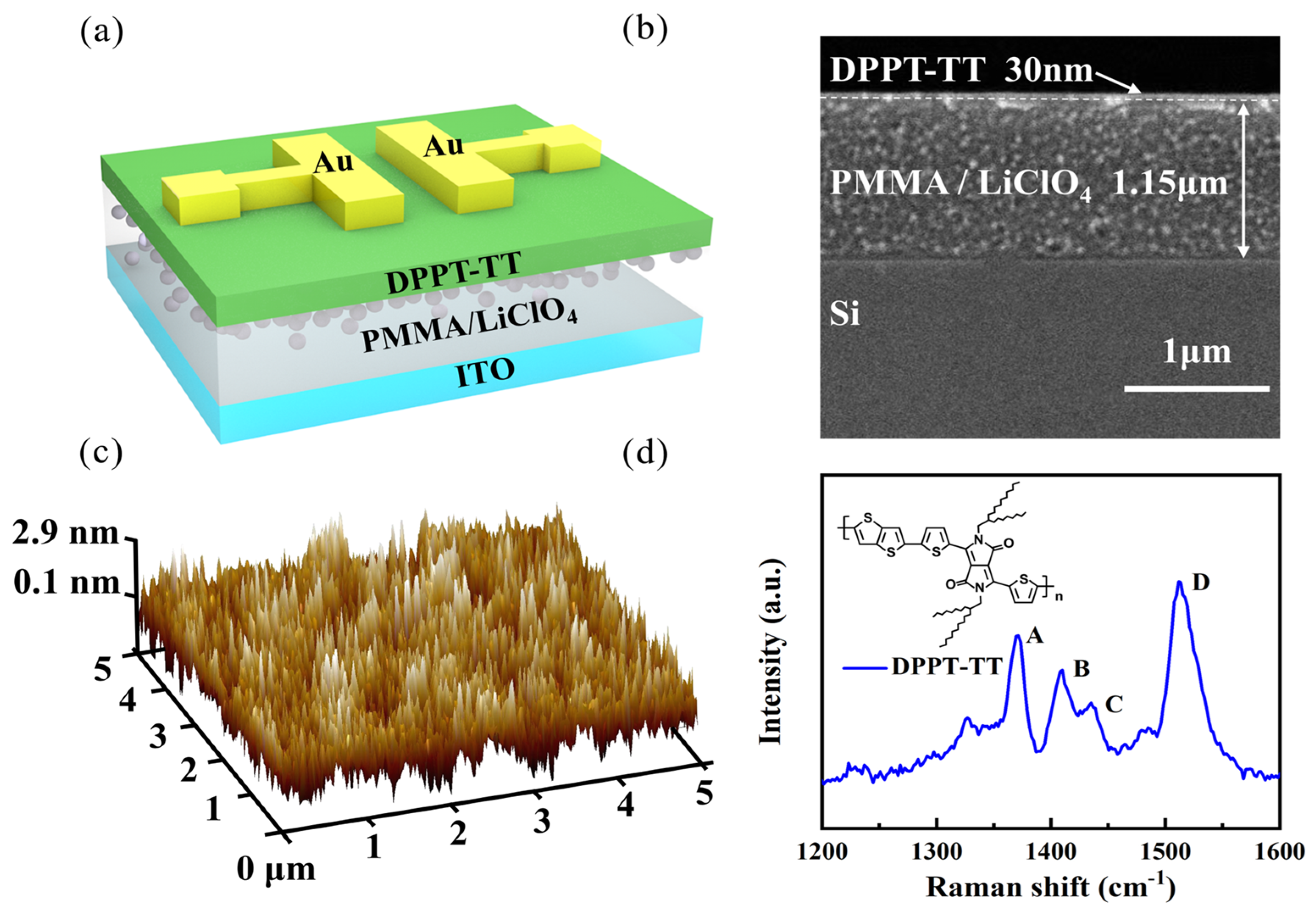
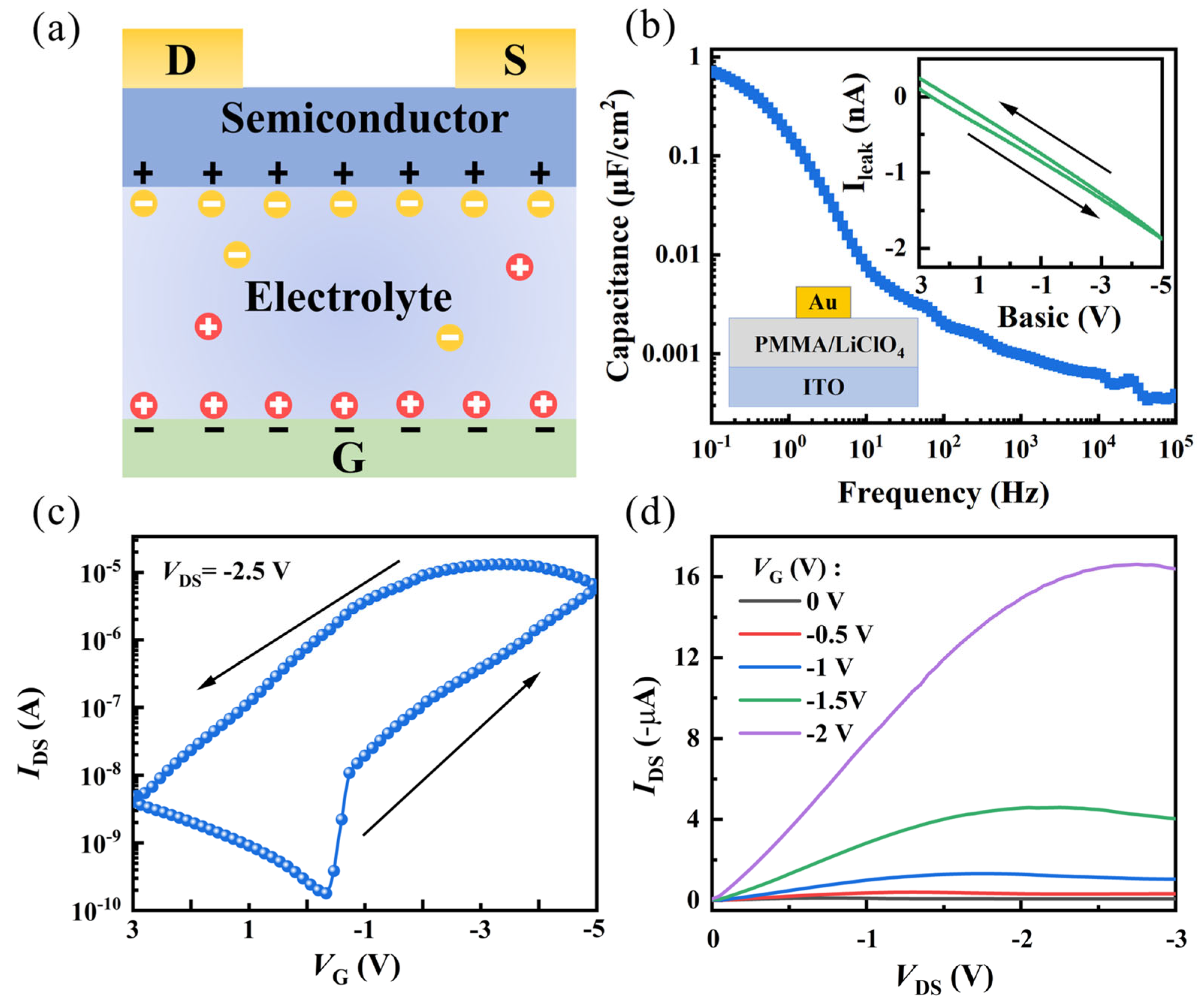
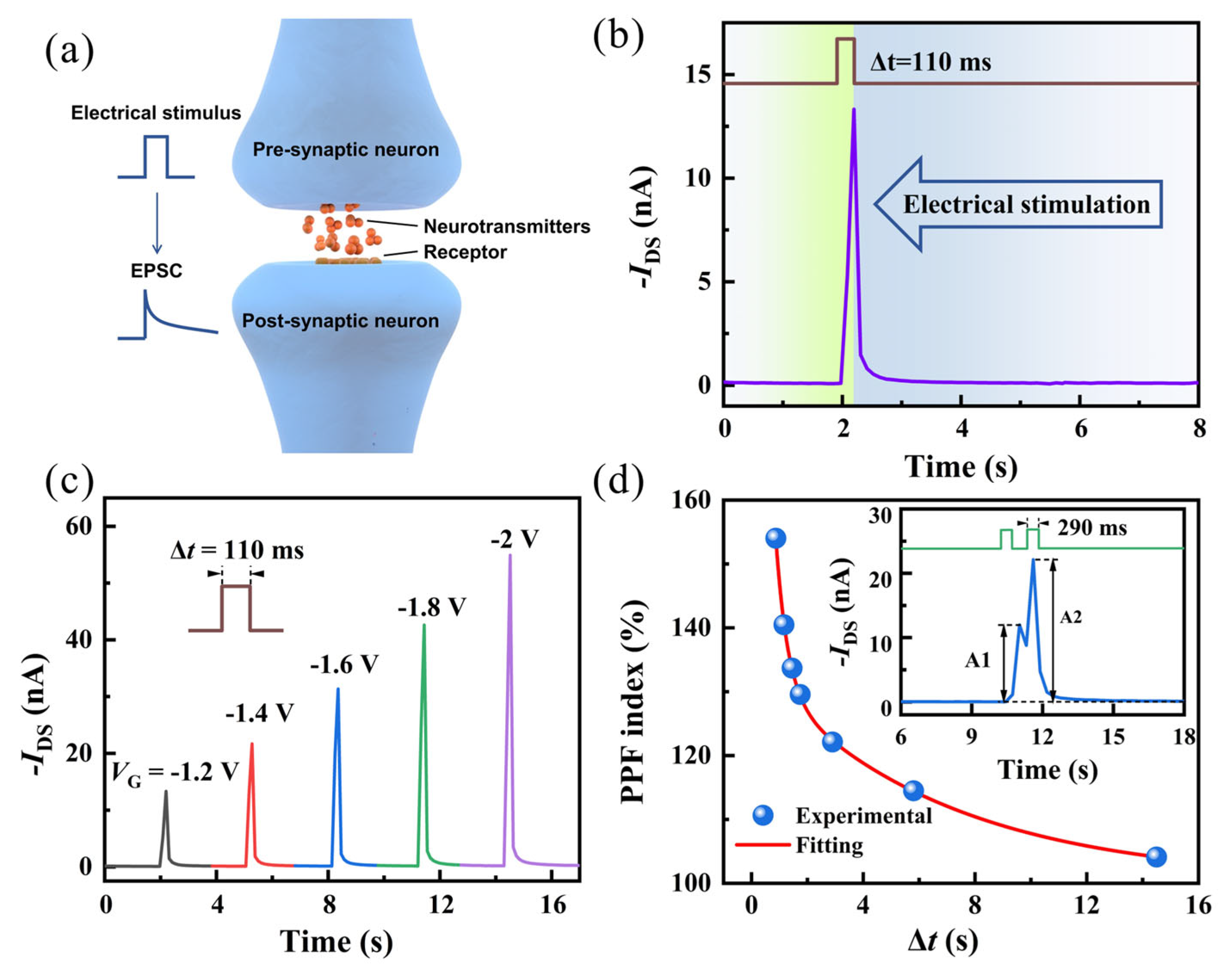
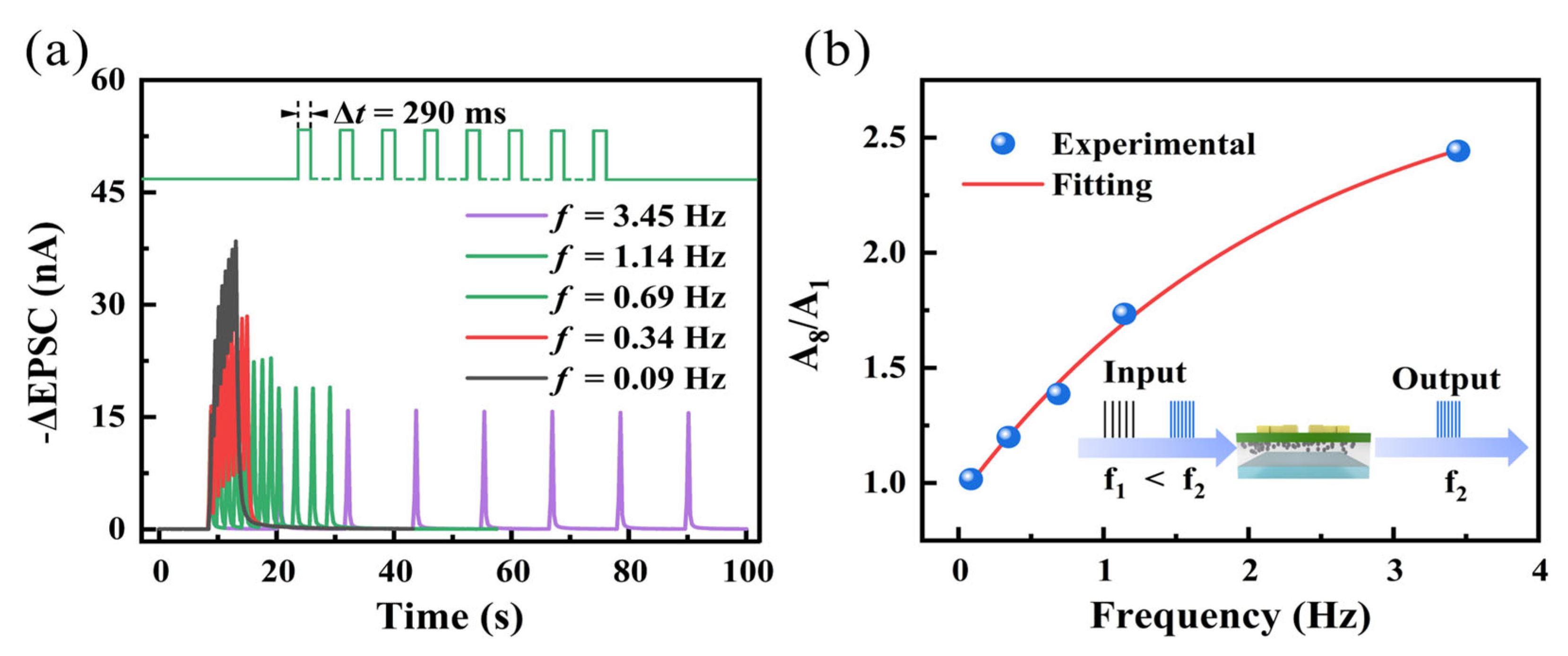
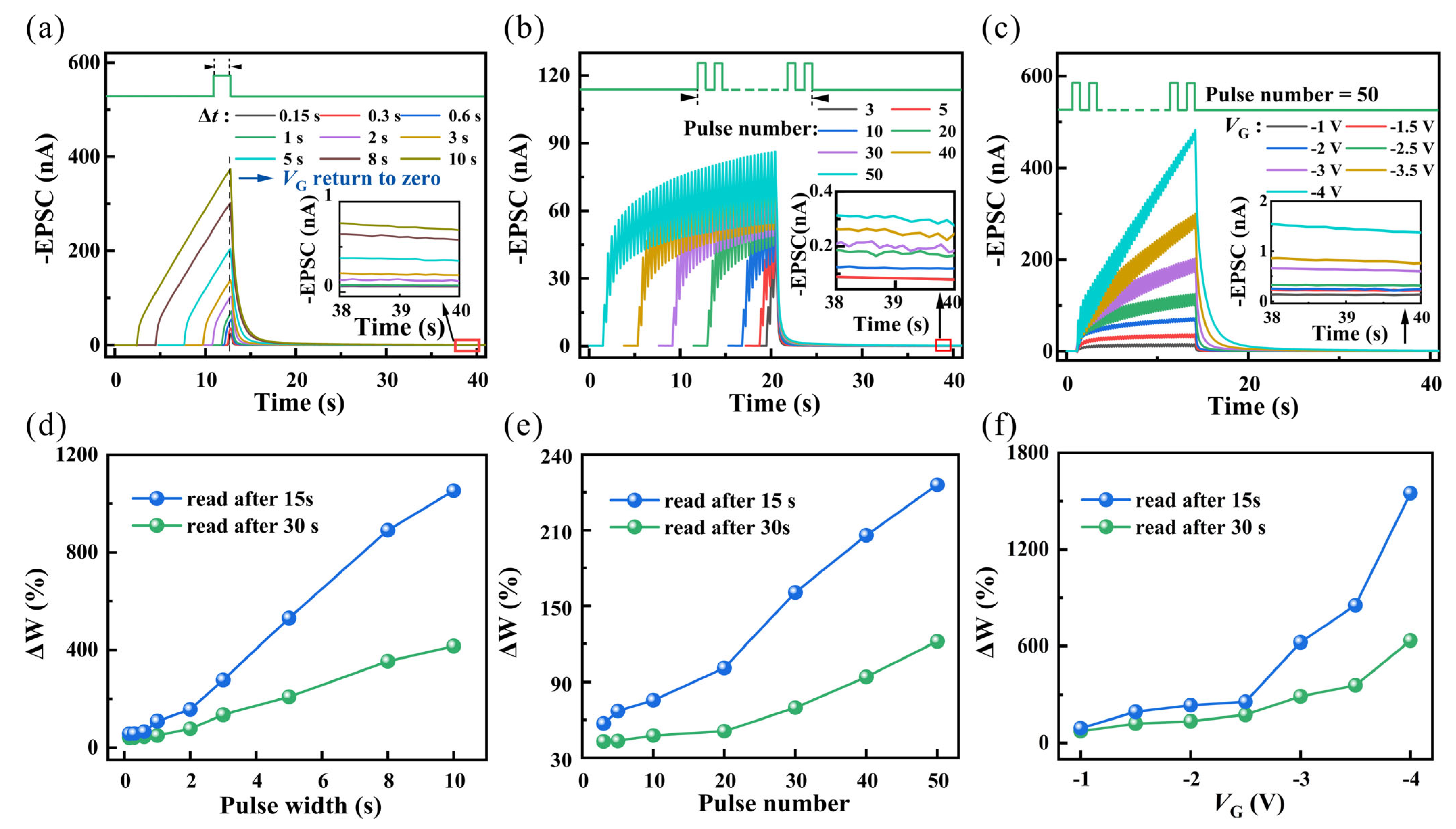

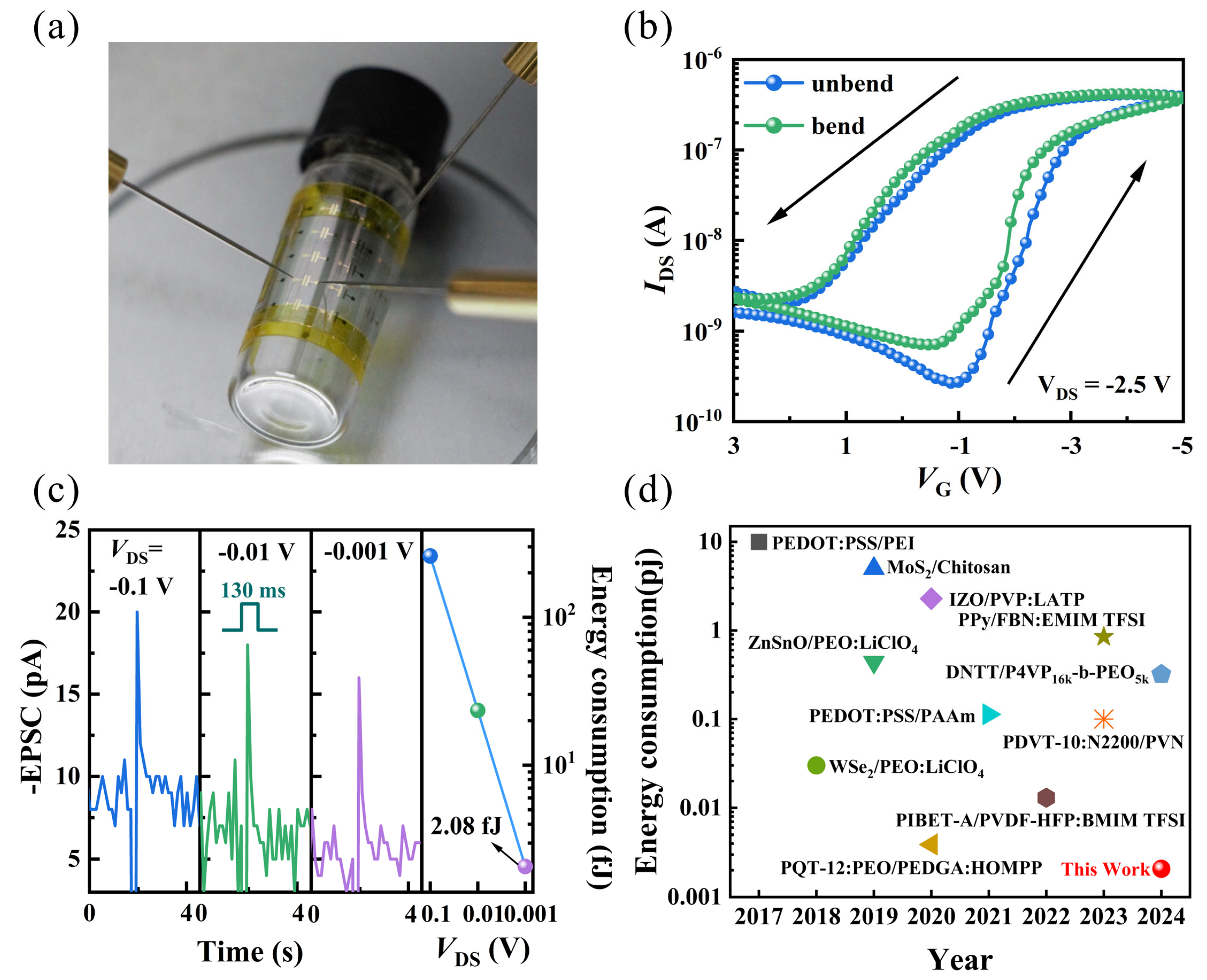
Disclaimer/Publisher’s Note: The statements, opinions and data contained in all publications are solely those of the individual author(s) and contributor(s) and not of MDPI and/or the editor(s). MDPI and/or the editor(s) disclaim responsibility for any injury to people or property resulting from any ideas, methods, instructions or products referred to in the content. |
© 2024 by the authors. Licensee MDPI, Basel, Switzerland. This article is an open access article distributed under the terms and conditions of the Creative Commons Attribution (CC BY) license (https://creativecommons.org/licenses/by/4.0/).
Share and Cite
Zhu, L.; Lin, J.; Zhu, Y.; Wu, J.; Wan, X.; Sun, H.; Yu, Z.; Xu, Y.; Tan, C. Flexible Organic Electrochemical Transistors for Energy-Efficient Neuromorphic Computing. Nanomaterials 2024, 14, 1195. https://doi.org/10.3390/nano14141195
Zhu L, Lin J, Zhu Y, Wu J, Wan X, Sun H, Yu Z, Xu Y, Tan C. Flexible Organic Electrochemical Transistors for Energy-Efficient Neuromorphic Computing. Nanomaterials. 2024; 14(14):1195. https://doi.org/10.3390/nano14141195
Chicago/Turabian StyleZhu, Li, Junchen Lin, Yixin Zhu, Jie Wu, Xiang Wan, Huabin Sun, Zhihao Yu, Yong Xu, and Cheeleong Tan. 2024. "Flexible Organic Electrochemical Transistors for Energy-Efficient Neuromorphic Computing" Nanomaterials 14, no. 14: 1195. https://doi.org/10.3390/nano14141195
APA StyleZhu, L., Lin, J., Zhu, Y., Wu, J., Wan, X., Sun, H., Yu, Z., Xu, Y., & Tan, C. (2024). Flexible Organic Electrochemical Transistors for Energy-Efficient Neuromorphic Computing. Nanomaterials, 14(14), 1195. https://doi.org/10.3390/nano14141195





